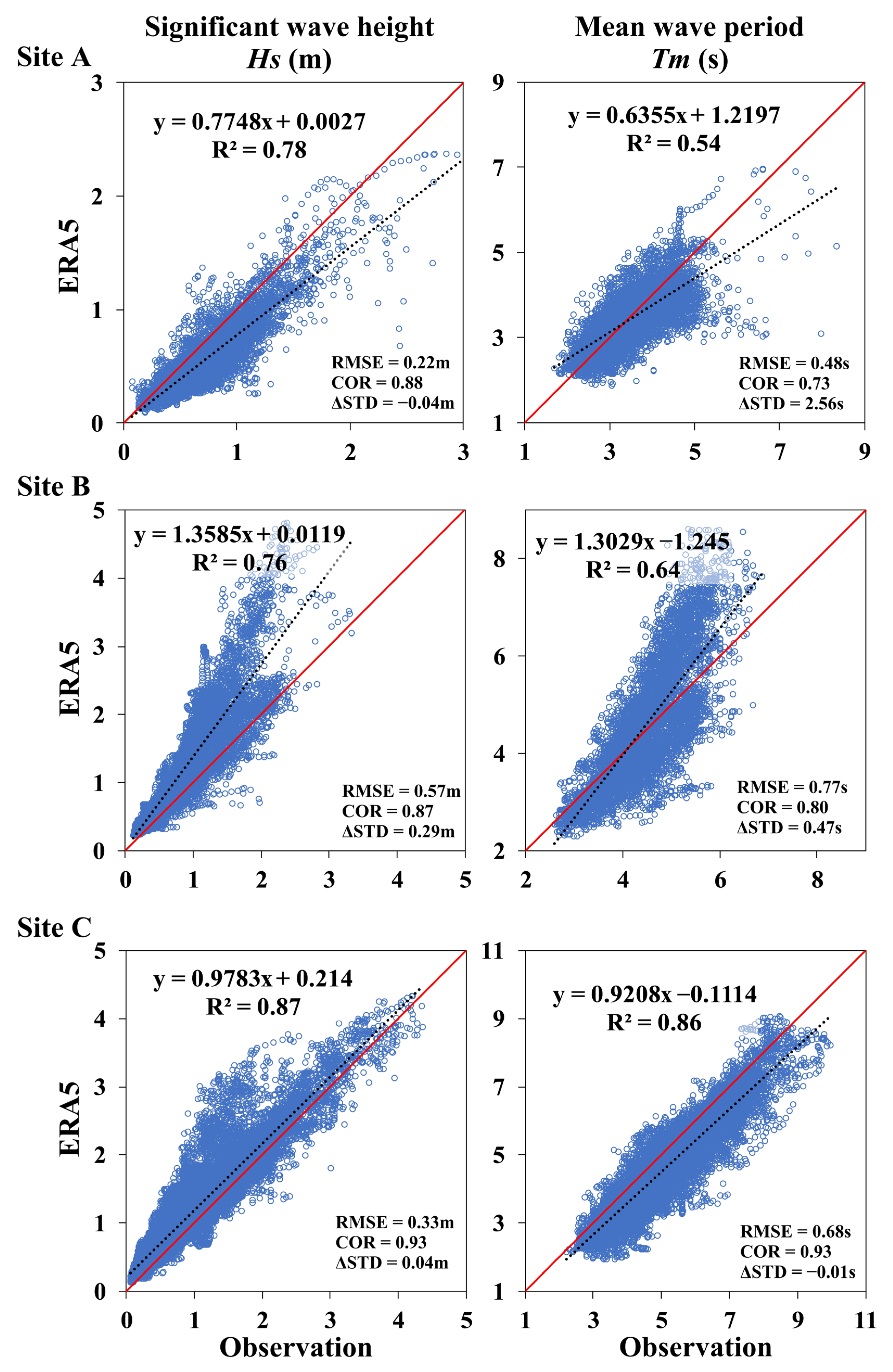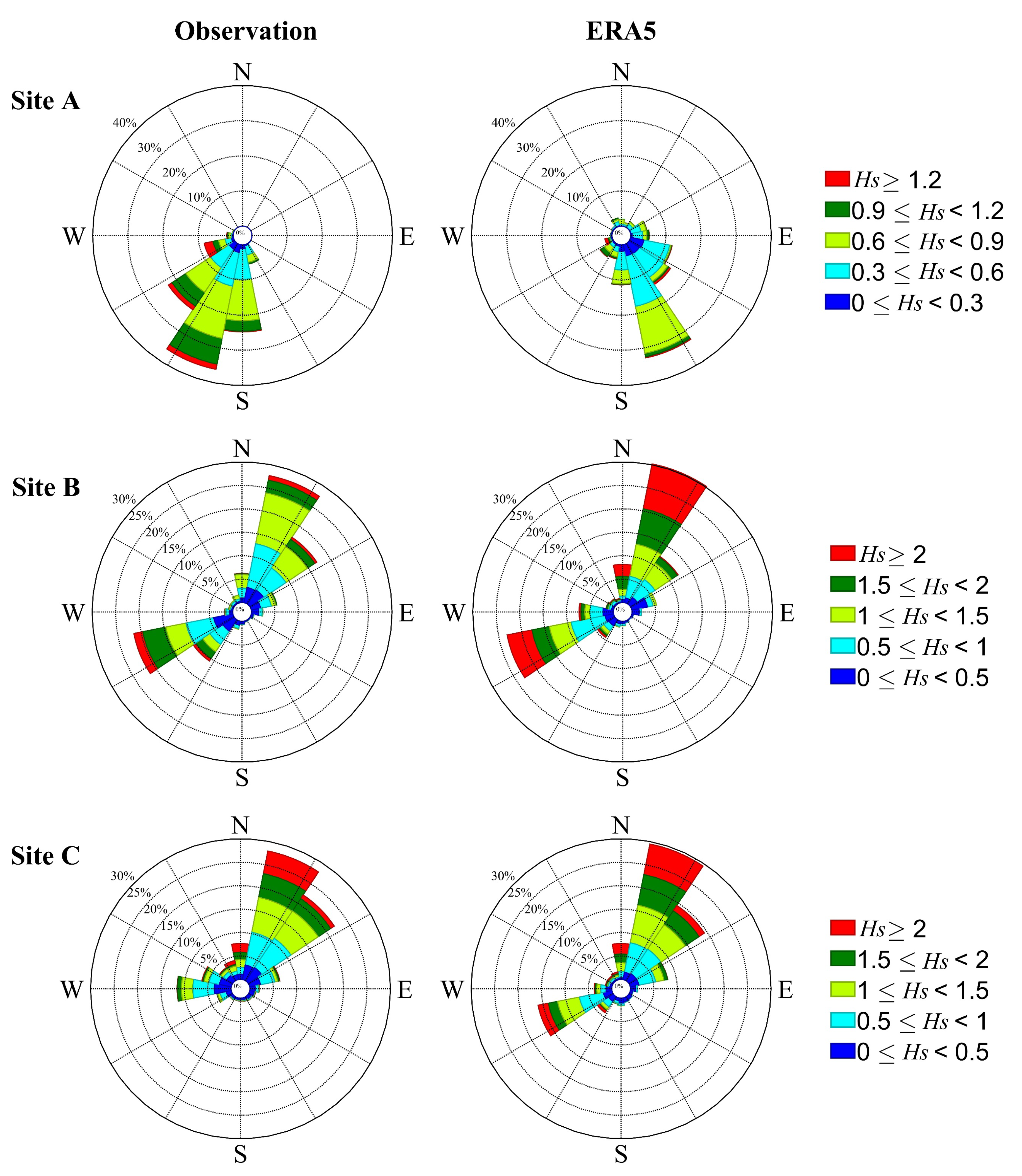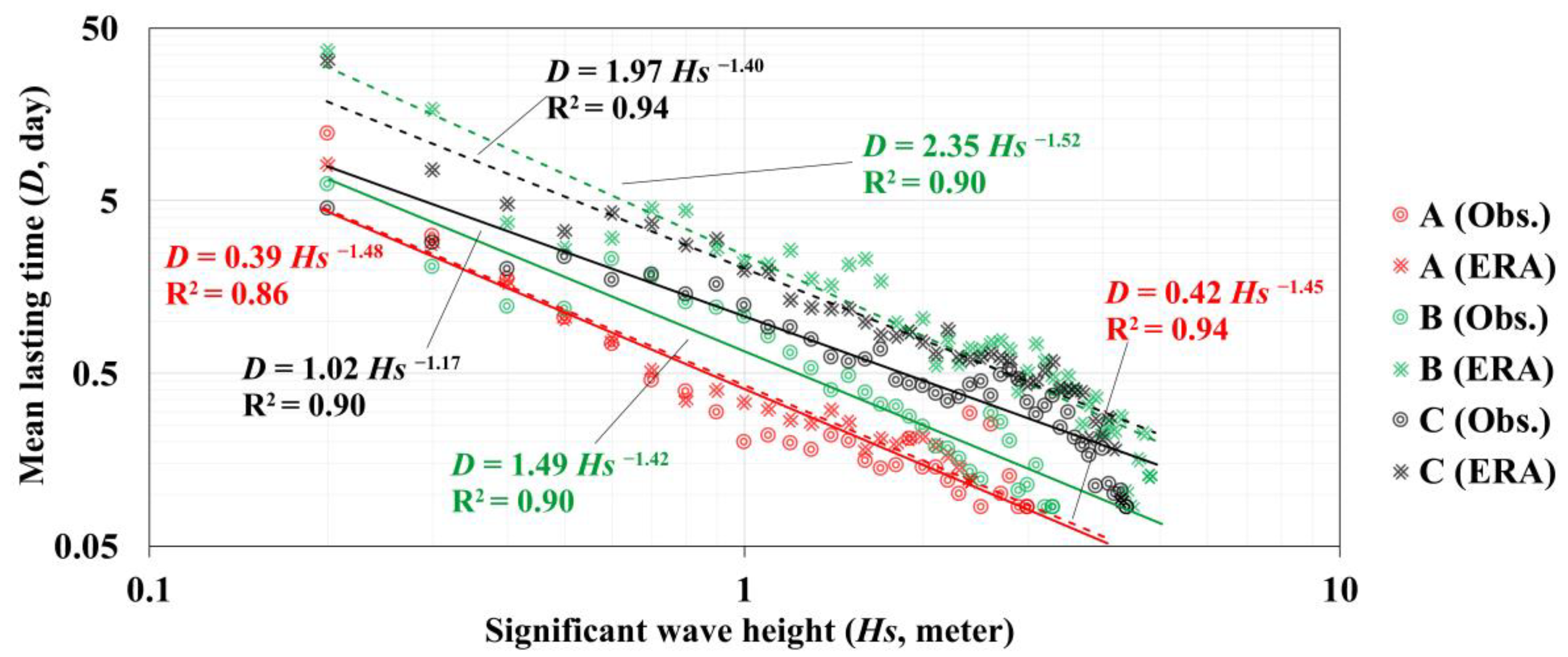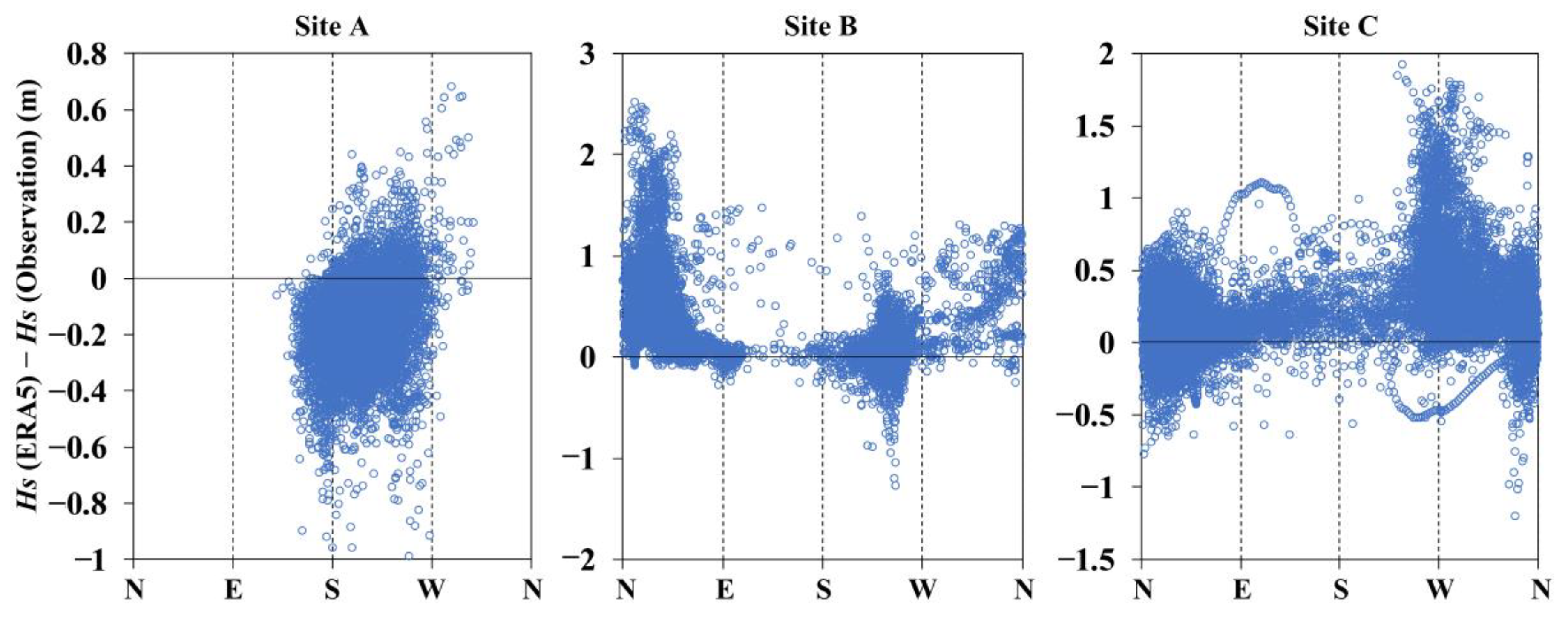Evaluation of ERA5 Wave Parameters with In Situ Data in the South China Sea
Abstract
:1. Introduction
2. Data and Methods
2.1. Wave Data from the ERA5 Dataset
2.2. In Situ Wave Measurements
2.3. Comparison Method
3. Results and Discussion
3.1. Comparison of Basic Wave Parameters
3.2. Comparison of Wave Parameters for Engineering Application
3.3. Analysis of Factors Causing Wave Parameter Error
4. Conclusions
Author Contributions
Funding
Data Availability Statement
Acknowledgments
Conflicts of Interest
References
- Wu, Z.; Chen, J.; Jiang, C.; Deng, B. Simulation of extreme waves using coupled atmosphere-wave modeling system over the South China Sea. Ocean Eng. 2021, 221, 108531. [Google Scholar] [CrossRef]
- Niu, Q.; Feng, Y. Relationships between the typhoon-induced wind and waves in the northern South China Sea. Geophys. Res. Lett. 2021, 48, e2020GL091665. [Google Scholar] [CrossRef]
- Li, B.; Chen, W.; Liu, J.; Li, J.; Wang, S.; Xing, H. Construction and application of nearshore hydrodynamic monitoring system for uninhabited islands. J. Coast. Res. 2020, 99, 131–136. [Google Scholar] [CrossRef]
- Chen, W.; Liu, J.; Li, J.; Sun, L.; Li, B.; Xing, H.; Shi, P. Wave energy assessment for the nearshore region of the northern South China Sea based on in situ observations. Energy Rep. 2022, 8, 149–158. [Google Scholar] [CrossRef]
- Li, B.; Li, J.; Liu, J.; Tang, S.; Chen, W.; Shi, P.; Liu, Y. Calibration experiments of CFOSAT wavelength in the Southern South China Sea by artificial neural networks. Remote Sens. 2022, 14, 773. [Google Scholar] [CrossRef]
- Su, H.; Wei, C.; Jiang, S.; Li, P.; Zhai, F. Revisiting the seasonal wave height variability in the South China Sea with merged satellite altimetry observations. Acta Oceanol. Sin. 2017, 36, 38–50. [Google Scholar] [CrossRef]
- Chu, P.C.; Qi, Y.; Chen, Y.; Shi, P.; Mao, Q. South China Sea wind-wave characteristics. Part I: Validation of Wavewatch-III using TOPEX/Poseidon data. J. Atmos. Ocean. Technol. 2004, 21, 1718–1733. [Google Scholar] [CrossRef] [Green Version]
- Li, B.; Li, J.; Li, Y.; Zhang, Z.; Shi, P.; Liu, J.; Chen, W. Application of artificial neural network to numerical wave simulation in the coastal region of island. J. Xiamen Univ. 2020, 59, 420–427. (In Chinese) [Google Scholar] [CrossRef]
- Sun, Z.; Zhang, H.; Xu, D.; Liu, X.; Ding, J. Assessment of wave power in the South China Sea based on 26-year high-resolution hindcast data. Energy 2020, 197, 117218. [Google Scholar] [CrossRef]
- Sun, Z.; Zhang, H.; Liu, X.; Ding, J.; Cai, Z. Wave energy assessment of the Xisha Group Islands zone for the period 2010–2019. Energy 2021, 220, 119721. [Google Scholar] [CrossRef]
- Cousineau, J.; Murphy, E. Numerical investigation of climate change effects on storm surges and extreme waves on Canada’s Pacific coast. Atmosphere 2022, 13, 311. [Google Scholar] [CrossRef]
- Jeong, S.-H.; Heo, K.-Y.; Son, J.-H.; Jo, Y.-H.; Choi, J.-Y.; Kwon, J.-I. Characteristics of swell-like waves in the east coast of Korea using atmospheric and wave hindcast data. Atmosphere 2022, 13, 286. [Google Scholar] [CrossRef]
- Hersbach, H.; Bell, B.; Berrisford, P.; Biavati, G.; Horányi, A.; Muñoz Sabater, J.; Nicolas, J.; Peubey, C.; Radu, R.; Rozum, I.; et al. ERA5 Hourly Data on Single Levels from 1979 to Present; Copernicus Climate Change Service (C3S) Climate Data Store (CDS): Reading, UK, 2018. [Google Scholar] [CrossRef]
- ECMWF IFS Documentation CY47R3—Part VII: ECMWF Wave Model. 2021. Available online: https://www.ecmwf.int/node/20201 (accessed on 31 December 2021).
- Wang, J.; Liu, J.; Wang, Y.; Liao, Z.; Sun, P. Spatiotemporal variations and extreme value analysis of significant wave height in the South China Sea based on 71-year long ERA5 wave reanalysis. Appl. Ocean Res. 2021, 113, 102750. [Google Scholar] [CrossRef]
- Shi, H.; Cao, X.; Li, Q.; Li, D.; Sun, J.; You, Z.; Sun, Q. Evaluating the accuracy of ERA5 wave reanalysis in the water around China. J. Ocean Univ. China 2021, 20, 1–9. [Google Scholar] [CrossRef]
- Tolman, H. Treatment of unresolved islands and ice in wind wave models. Ocean Model. 2003, 5, 219–231. [Google Scholar] [CrossRef]
- Mao, K.; Chen, X.; Wang, L. Research progress of spectral wave mode of archipelago or reef ocean region. Acta Oceanol. Sin. 2014, 36, 161–169. (In Chinese) [Google Scholar] [CrossRef]
- Jiang, H.; Su, F.; Zhou, C.; Yang, X.; Wang, Q.; Cheng, F. The geographical characteristics of Nansha Islands in the South China Sea. J. Geogr. Sci. 2018, 28, 957–972. [Google Scholar] [CrossRef] [Green Version]
- Bruno, M.F.; Molfetta, M.G.; Totaro, V.; Mossa, M. Performance assessment of ERA5 wave data in a swell dominated region. J. Mar. Sci. Eng. 2020, 8, 214. [Google Scholar] [CrossRef] [Green Version]
- Tarek, M.; Brissette, F.P.; Arsenault, R. Evaluation of the ERA5 reanalysis as a potential reference dataset for hydrological modelling over North America. Hydrol. Earth Syst. Sci. 2020, 24, 2527–2544. [Google Scholar] [CrossRef]
- Molina, M.O.; Gutiérrez, C.; Sánchez, E. Comparison of ERA5 surface wind speed climatologies over Europe with observations from the HadISD dataset. Int. J. Climatol. 2021, 41, 4864–4878. [Google Scholar] [CrossRef]
- Shikhovtsev, A.Y.; Kovadlo, P.G.; Khaikin, V.B.; Nosov, V.V.; Lukin, V.P.; Nosov, E.V.; Torgaev, A.V.; Kiselev, A.V.; Shikhovtsev, M.Y. Atmospheric conditions within big telescope alt-azimuthal region and possibilities of astronomical observations. Remote Sens. 2022, 14, 1833. [Google Scholar] [CrossRef]
- Li, B.; Chen, W.; Li, J.; Liu, J.; Shi, P.; Xing, H. Wave energy assessment based on reanalysis data calibrated by buoy observations in the southern South China Sea. Energy Rep. 2022, 8, 5067–5079. [Google Scholar] [CrossRef]
- Lawson, N.V.; Abernethy, C.L. Long term wave statistics off Botany Bay. In Second Australian Conference on Coastal and Ocean Engineering, 1975: The Engineer, the Coast and the Ocean; The Institution of Engineers: Sydney, Australia, 1975; pp. 169–178. Available online: https://search.informit.org/doi/10.3316/informit.914127290484662 (accessed on 31 December 2021).
- Graham, C. The parameterisation and prediction of wave height and wind speed persistence statistics for oil industry operational planning purposes. Coast. Eng. 1982, 6, 303–329. [Google Scholar] [CrossRef]
- Feng, X.; Li, J.; Yin, B.; Yang, D.; Chen, H.; Gao, G. Characteristics of ocean waves in coastal area of Dongfang, Hainan Island based on observations. J. Trop. Oceanogr. 2018, 37, 1–8. (In Chinese) [Google Scholar] [CrossRef]
- Wang, H.; Fu, D.; Liu, D.; Xiao, X.; Liu, B. Analysis and prediction of significant wave height in the Beibu Gulf, South China Sea. J. Geophys. Res. Oceans 2021, 126, e2020JC017144. [Google Scholar] [CrossRef]
- Chang, M.-H.; Lien, R.-C.; Lamb, K.G.; Diamessis, P.J. Long-term observations of shoaling internal solitary waves in the northern South China Sea. J. Geophys. Res. Ocean. 2021, 126, e2020JC017129. [Google Scholar] [CrossRef]
- Quan, Q.; Cai, Z.; Jin, G.; Liu, Z. Topographic rossby waves in the abyssal South China Sea. J. Phys. Oceanogr. 2021, 51, 1795–1812. [Google Scholar] [CrossRef]
- Zheng, H.; Zhu, X.-H.; Zhang, C.; Zhao, R.; Zhu, Z.-N.; Liu, Z.-J. Propagation of topographic rossby waves in the deep basin of the South China Sea based on abyssal current observations. J. Phys. Oceanogr. 2021, 51, 2783–2791. [Google Scholar] [CrossRef]






| Site | Longitude and Latitude | Depth | Observation Period |
|---|---|---|---|
| A | 18.3° N, 109.0° E | 12 m | June 2020 to September 2021 |
| B | 9.5° N, 113.0° E | 1240 m | October 2020 to October 2021 |
| C | 10.0° N, 115.5° E | 1200 m | November 2018 to June 2021 |
Publisher’s Note: MDPI stays neutral with regard to jurisdictional claims in published maps and institutional affiliations. |
© 2022 by the authors. Licensee MDPI, Basel, Switzerland. This article is an open access article distributed under the terms and conditions of the Creative Commons Attribution (CC BY) license (https://creativecommons.org/licenses/by/4.0/).
Share and Cite
Liu, J.; Li, B.; Chen, W.; Li, J.; Yan, J. Evaluation of ERA5 Wave Parameters with In Situ Data in the South China Sea. Atmosphere 2022, 13, 935. https://doi.org/10.3390/atmos13060935
Liu J, Li B, Chen W, Li J, Yan J. Evaluation of ERA5 Wave Parameters with In Situ Data in the South China Sea. Atmosphere. 2022; 13(6):935. https://doi.org/10.3390/atmos13060935
Chicago/Turabian StyleLiu, Junliang, Bo Li, Wuyang Chen, Junmin Li, and Jing Yan. 2022. "Evaluation of ERA5 Wave Parameters with In Situ Data in the South China Sea" Atmosphere 13, no. 6: 935. https://doi.org/10.3390/atmos13060935
APA StyleLiu, J., Li, B., Chen, W., Li, J., & Yan, J. (2022). Evaluation of ERA5 Wave Parameters with In Situ Data in the South China Sea. Atmosphere, 13(6), 935. https://doi.org/10.3390/atmos13060935







